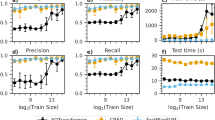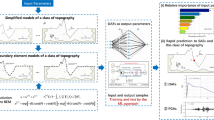Abstract
Traditional approaches require a velocity model to compute travel times for estimating the location of earthquakes. Moreover, the velocity model typically assumed is layered in nature, ignoring the perturbations around the background velocity model. In this study, we propose a novel method that does not require any assumption on a velocity model. Also, triangulation estimates of location require three-station recordings. Even if the single station is used, three components of recordings are needed. In this work, we propose a machine learning method, based on support vector machines (SVM), that can predict earthquake location and magnitude with just one component (vertical) of a single station. Machine learning methods are typically used for either regression or classification. Literature shows that the SVM algorithm is promising for the classification of an arbitrary signal. This research demonstrates that, by using complementary input features from a seismic recording, a comparable performance can be obtained, with a substantial reduction in detection time. Furthermore, only the vertical component of a single recording station data is used to train the network. The SVM algorithm is applied on synthetic seismograms from 400 earthquakes of different focal mechanisms and magnitudes. This falls under supervised machine learning, as we give the input features and use them for training the model. Overfitting is avoided by tenfold cross-validation, i.e., the algorithm is repeated ten times, each time giving a different 10% as a testing portion. The classifier's performance is quite good, on the synthetic noise-free data, in predicting the magnitude, elevation angle, and hypocentral distance, but not the azimuthal angle. The trained model in the present work can be readily used where noise levels are quite low without sophisticated ray-tracing or Green's function computation. The performance of the algorithm is checked by adding additive noise to the data. The novelty of this work is that knowledge of the velocity model is not required, and the estimation of magnitude and the origin of the earthquake are done using the single-station/single-component earthquake records.




















Similar content being viewed by others
Data Availability
Not applicable.
Code Availability
SPECFEM3D is an open-source software freely available through GitHub (https://github.com/geodynamics/specfem3d).
References
Asencio-Cortés, G., Martínez-Álvarez, F., Troncoso, A., & Morales-Esteban, A. (2017). Medium–large earthquake magnitude prediction in Tokyo with artificial neural networks. Neural Computing and Applications, 28(5), 1043–1055. https://doi.org/10.1007/s00521-015-2121-7
Asim, K. M., Javed, F., Hainzl, S., & Iqbal, T. (2019). Fault parameters-based earthquake magnitude estimation using artificial neural networks. Seismological Research Letters, 90(4), 1544–1551. https://doi.org/10.1785/0220190051
Audretsch, J. (2020). Earthquake Detection using Deep Learning Based Approaches (Thesis). https://doi.org/10.25781/KAUST-52098
Bellagamba, X., Lee, R., & Bradley, B. A. (2019). A neural network for automated quality screening of ground motion records from small magnitude earthquakes. Earthquake Spectra, 35(4), 1637–1661. https://doi.org/10.1193/122118EQS292M
Bergen, K. J., Chen, T., & Li, Z. (2019). Preface to the focus section on machine learning in seismology. Seismological Research Letters, 90(2A), 477–480. https://doi.org/10.1785/0220190018
Bianco, M. J., Gerstoft, P., Olsen, K. B., & Lin, F.-C. (2019). High-resolution seismic tomography of Long Beach, CA using machine learning. Scientific Reports, 9(1), 14987. https://doi.org/10.1038/s41598-019-50381-z
Christianini, N., & Shawe-Taylor, J. (2000). An introduction to support vector machines and other kernel-based learning methods. Cambridge University Press.
Clayton, R., & Engquist, B. (1977). Absorbing boundary conditions for acoustic and elastic wave equations. Bulletin of the seismological society of America, 67(6), 1529–1540
DeVries, P. M. R., Viégas, F., Wattenberg, M., & Meade, B. J. (2018). Deep learning of aftershock patterns following large earthquakes. Nature, 560(7720), 632–634. https://doi.org/10.1038/s41586-018-0438-y
Gentili, S., & Bragato, P. (2006). A neural-tree-based system for automatic location of earthquakes in Northeastern Italy. Journal of Seismology, 10(1), 73–89. https://doi.org/10.1007/s10950-005-9001-z
Hardebeck, J. L. (2002). A new method for determining first-motion focal mechanisms. Bulletin of the Seismological Society of America, 92(6), 2264–2276. https://doi.org/10.1785/0120010200
Hastie, T., Tibshirani, R., & Friedman, J. (2008). The elements of statistical learning. (2nd ed.). Springer.
Herglotz, G. (1907). Über das Benndorfsche Problem der Fortpflanzungsgeschwindigkeit der Erdbebenstrahlen. Zeitschrift fúr Geophys, 8, 145–147
Jiao, P., & Alavi, A. H. (2020). Artificial intelligence in seismology: advent, performance and future trends. Geoscience Frontiers, 11(3), 739–744. https://doi.org/10.1016/j.gsf.2019.10.004
Karasözen, E., & Karasözen, B. (2020). Earthquake location methods. GEM International Journal on Geomathematics, 11(1), 13. https://doi.org/10.1007/s13137-020-00149-9
Kislov, K. V., & Gravirov, V. V. (2017). Use of artificial neural networks for classification of noisy seismic signals. Seismic Instruments, 53(1), 87–101
Komatitsch, D., & Tromp, J. (2002a). Spectral-element simulations of global seismic wave propagation—I. Validation. Geophysical Journal International, 149(2), 390–412
Komatitsch, D., & Tromp, J. (2002b). Spectral-element simulations of global seismic wave propagation—II. Three-dimensional models, oceans, rotation and self-gravitation. Geophysical Journal International, 150(1), 303–318
Kong, Q., Trugman, D. T., Ross, Z. E., Bianco, M. J., Meade, B. J., & Gerstoft, P. (2019). Machine learning in seismology: turning data into insights. Seismological Research Letters, 90(1), 3–14. https://doi.org/10.1785/0220180259
Lomax, A., Michelini, A., & Jozinović, D. (2019). An Investigation of rapid earthquake characterization using single-station waveforms and a convolutional neural network. Seismological Research Letters, 90(2A), 517–529. https://doi.org/10.1785/0220180311
Mignan, A., & Broccardo, M. (2019). One neuron is more informative than a deep neural network for aftershock pattern forecasting. Nature, 574(7776), E1–E3. https://doi.org/10.1038/s41586-019-1582-8
Mousavi, S. M., & Beroza, G. C. (2020). Bayesian-deep-learning estimation of earthquake location from single-station observations. IEEE Transactions on Geoscience and Remote Sensing, 58(11), 8211–8224. https://doi.org/10.1109/TGRS.2020.2988770.
Ross, Z. E., Meier, M.-A., & Hauksson, E. (2018). P wave arrival picking and first-motion polarity determination with deep learning. Journal of Geophysical Research: Solid Earth, 123(6), 5120–5129. https://doi.org/10.1029/2017JB015251
Tian, X., Zhang, W., Zhang, X., Zhang, J., Zhang, Q., Wang, X., & Guo, Q. (2020). Comparison of single-trace and multiple-trace polarity determination for surface microseismic data using deep learning. Seismological Research Letters, 91(3), 1794–1803. https://doi.org/10.1785/0220190353
Tibi, R., Linville, L., Young, C., & Brogan, R. (2019). Classification of local seismic events in the Utah region: a comparison of amplitude ratio methods with a spectrogram-based machine learning approach classification of local seismic events in the Utah region. Bulletin of the Seismological Society of America, 109(6), 2532–2544. https://doi.org/10.1785/0120190150
Tiira, T. (1999). Detecting teleseismic events using artificial neural networks. Computers and Geosciences, 25, 929–938. https://doi.org/10.1016/S0098-3004(99)00056-4
Vapnik, V. (2013). The nature of statistical learning theory. Springer science & business media.
Wiechert, E. (1910). Bestimmung des Weges der Erdbebenwellen im Erdinnern. I. Theoretisches. Physikalishce Zeitschrift, 11, 294–304
Wiejacz, P., & Wiszniowski, J. (2006). Moment magnitude determination of local seismic events recorded at selected Polish seismic stations. Acta Geophysica, 54(1), 15–32. https://doi.org/10.2478/s11600-006-0003-1
Xie, Y., Ebad Sichani, M., Padgett, J. E., & DesRoches, R. (2020). The promise of implementing machine learning in earthquake engineering: a state-of-the-art review. Earthquake Spectra. https://doi.org/10.1177/8755293020919419
Yang, W., Hauksson, E., & Shearer, P. M. (2012). Computing a large refined catalog of focal mechanisms for Southern California (1981–2010): temporal stability of the style of faulting. Bulletin of the Seismological Society of America, 102(3), 1179–1194. https://doi.org/10.1785/0120110311
Yoon, C. E., Bergen, K. J., Rong, K., Elezabi, H., Ellsworth, W. L., Beroza, G. C., & Levis, P. (2019). Unsupervised large-scale search for similar earthquake signals. Bulletin of the Seismological Society of America, 109(4), 1451–1468. https://doi.org/10.1785/0120190006
Zhou, Y., Yue, H., Kong, Q., & Zhou, S. (2019). Hybrid event detection and phase-picking algorithm using convolutional and recurrent neural networks. Seismological Research Letters, 90(3), 1079–1087. https://doi.org/10.1785/0220180319
Acknowledgements
We thank the two anonymous reviewers for their comments and suggestions, which have significantly improved the manuscript. Funding from the Ministry of Earth Sciences, India through grant MoES/P.O.(Seismo)/1(304)/2016 is gratefully acknowledged.
Funding
Ministry of Earth Sciences, India.
Author information
Authors and Affiliations
Corresponding author
Ethics declarations
Conflict of Interest
The authors declare no conflict of interest.
Additional information
Publisher's Note
Springer Nature remains neutral with regard to jurisdictional claims in published maps and institutional affiliations.
Rights and permissions
About this article
Cite this article
Chanda, S., Somala, S.N. Single-Component/Single-Station–Based Machine Learning for Estimating Magnitude and Location of an Earthquake: A Support Vector Machine Approach. Pure Appl. Geophys. 178, 1959–1976 (2021). https://doi.org/10.1007/s00024-021-02745-8
Received:
Revised:
Accepted:
Published:
Issue Date:
DOI: https://doi.org/10.1007/s00024-021-02745-8




